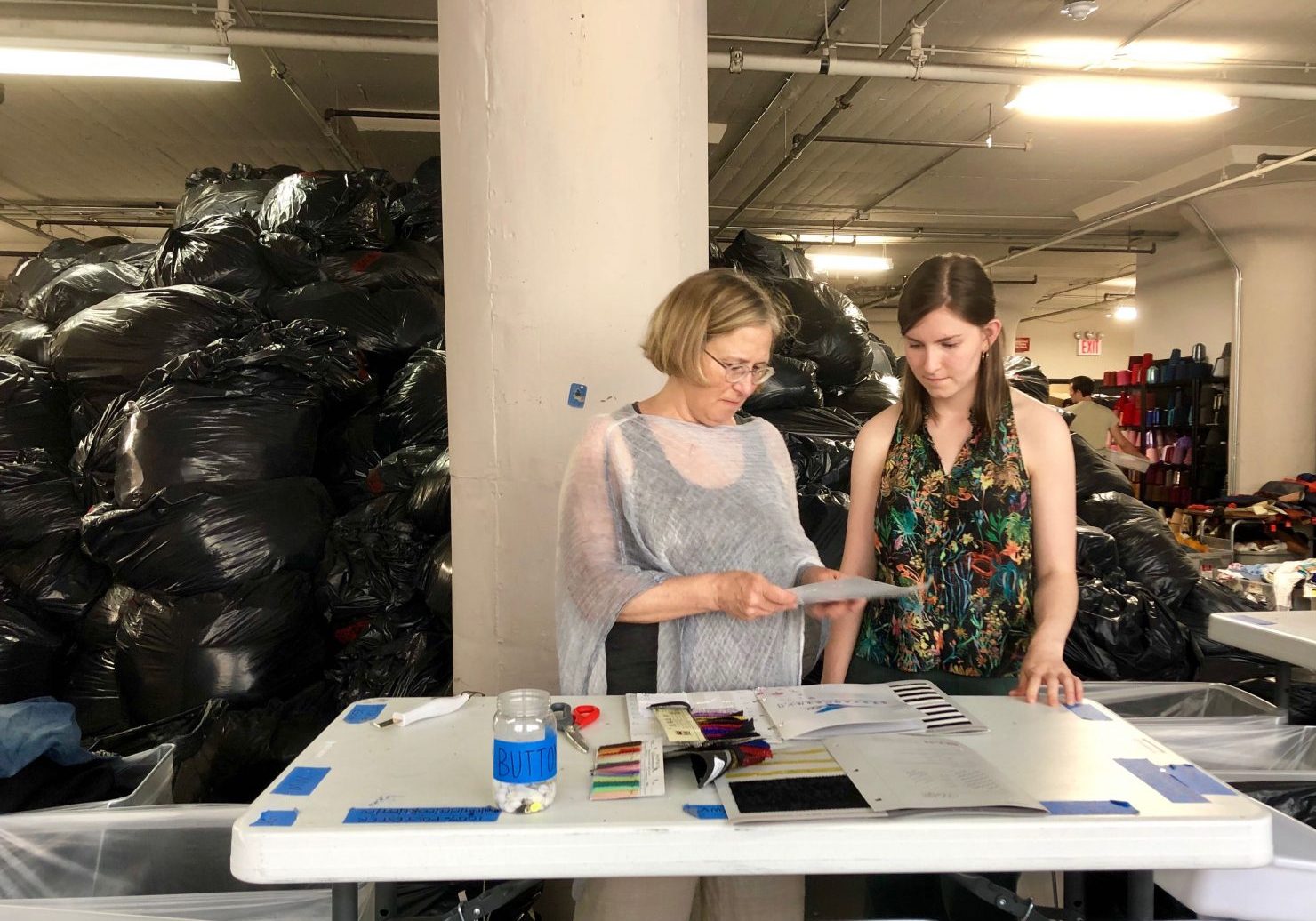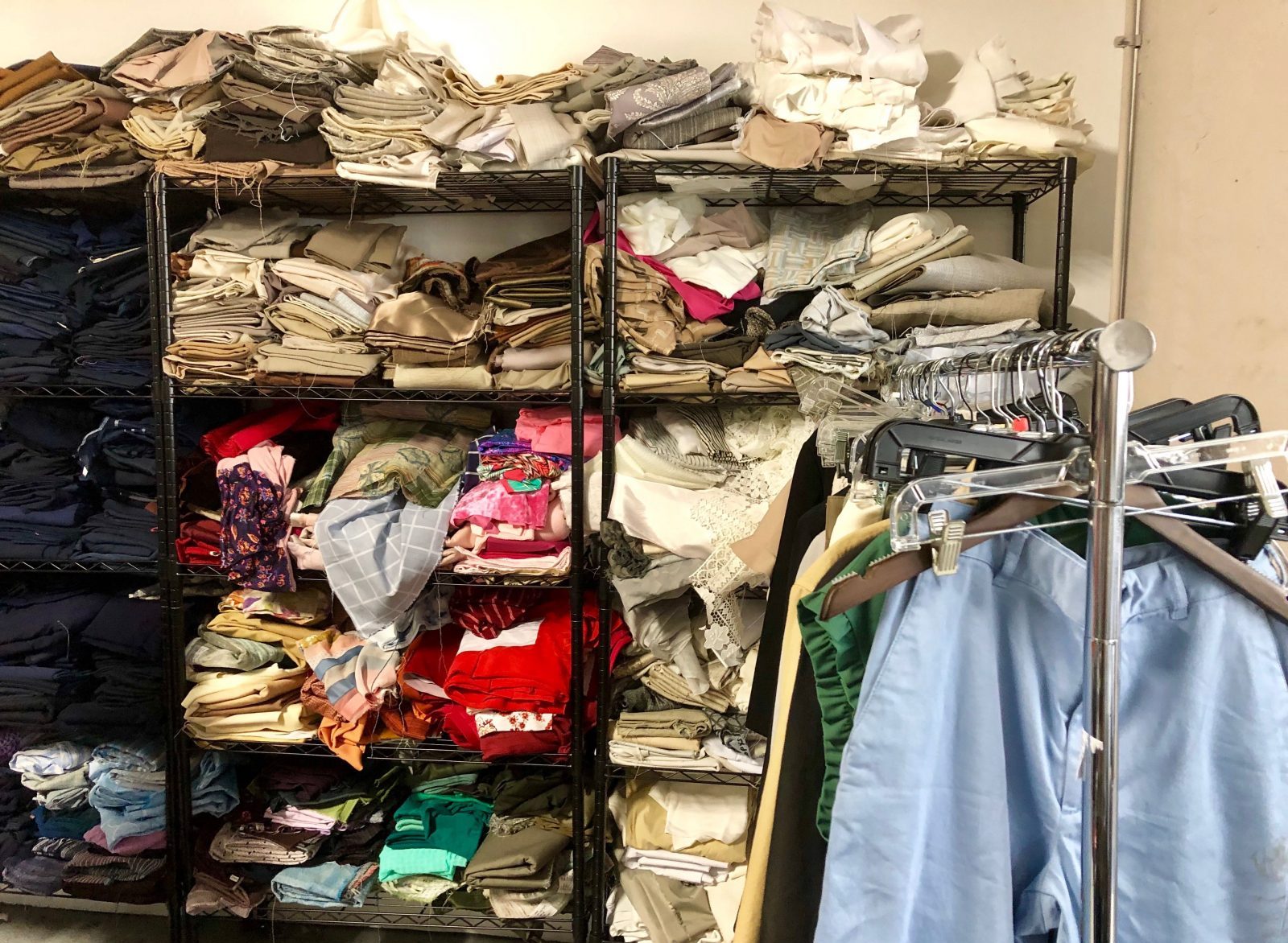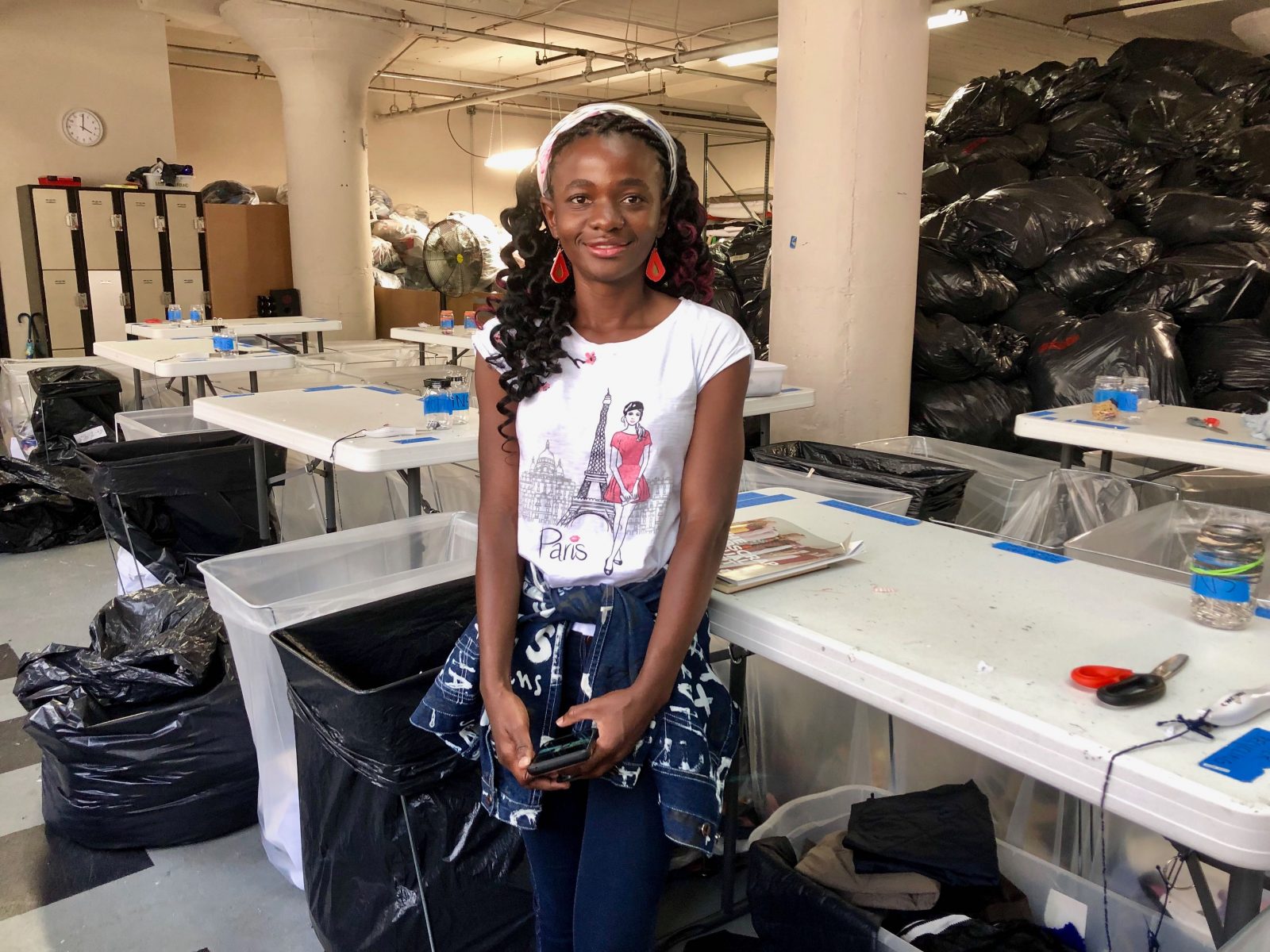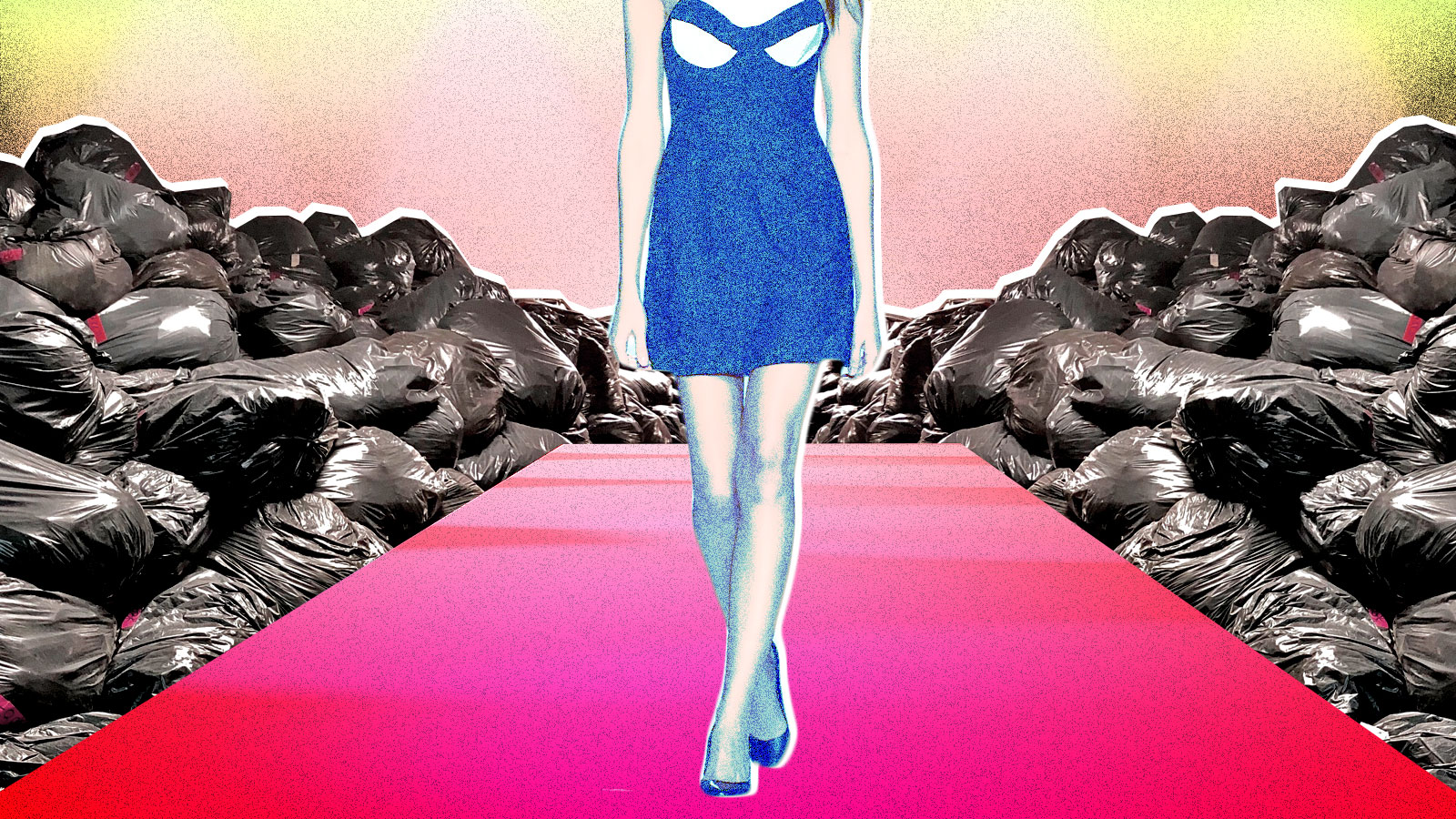On a sunny June day in Brooklyn, sunlight filtered through the frosted glass in an army terminal turned warehouse, where a dozen or so design students were sifting through a floor-to-ceiling hill of pristine textiles. They ripped apart bundles of cotton and polyester swatches, removing pins and staples and sorting garments into separate recycling bins by material type. For unlabeled clothing samples, the students pulled at the fabric to test for stretch: spandex melts at high temperatures and can make a big mess when recycled.
It was tedious, time-consuming work. But, according to their teacher, Donna Maione, a necessary lesson in sustainability. Last school year, Maione started bringing her students at Parsons School of Design here to give them a first-hand look at the current state wastefulness on the maker side of the fashion industry. Her goal isn’t necessarily to shock and shame the fashion-forward among them, but to introduce new questions: What is considered waste? What can we make from what’s left behind? And, better yet, can we design to eliminate this excess stuff in the first place?

Donna Maione (center) talks with FABSCRAP community coordinator Annie Keating at their Brooklyn warehouse. Maione took her fashion students on a field trip to the facility as part of a lesson on sustainability. Justine Calma / Grist.
A fashion emergency
Considering the climate when it comes to our clothes is important since more than 60 percent of textile fibers are derived from fossil fuels (petrochemicals). On top of that, The United Nations estimated that the business of what we wear, including its long supply chains, is responsible for 10 percent of the greenhouse gas emissions heating our planet. As an industry, fashion uses up even more energy than aviation and shipping combined.
In 2015, the Environmental Protection Agency estimated that individual Americans generated 16 million tons of textile waste. New Yorkers alone throw away 200,000 tons of clothes, linens, shoes, and accessories each year. Only about 15 percent of unwanted apparel ends up being recycled. The remaining 85 percent is burned or added to municipal landfills.
But consumer kondo-ing isn’t even the biggest source of the fashion industry’s waste problem. Although no one is keeping exact track of the scale, commercial textile waste is estimated to account for about 40 times as much fashion waste as residential dumping.
It’s not just fast fashion that’s bad for the environment. It’s been estimated that 15 to 20 percent of the fabric used in all clothing designs winds up as trash on the cutting room floor. Designers at both high- and low-ends of the fashion spectrum dispose of extra yardage — often perfectly good fabric plus all the lace and trimmings. Clothing samples may go from the runway straight to the dumpster once their usefulness has run its course. Some high-end labels allegedly burn their excess stock rather than chance them ending up in a discount store and harming the luxury reputation of their brand.

Rescued textiles at the FABSCRAP warehouse in Brooklyn. Justine Calma / Grist
There are laws in place that are supposed to reduce fashion manufacturing waste. New York City actually requires companies that generate waste consisting of more than 10 percent textiles to recycle rather than trash their excess fabric. But tracking companies’ waste is challenging; making the recycling law difficult to enforce. Companies aren’t required to report their waste streams to the city, nor does the city’s Department of Sanitation pick up trash from commercial businesses. Instead, companies hire private carters to collect their garbage and recycling, keeping their waste under wraps, so to speak.
Maione knows from experience just how bad fashion can be for the environment. Prior to teaching a sustainable systems class at Parsons School of Design, Maione designed clothes for the likes of Liz Claiborne, Macy’s, and at one point had her own clothing label. She went on to spend 12 years leading ‘product lifecycle management’ at Jones New York, where she started to realize how short the ‘lifecycle’ of a piece of clothing can be.
Many design concepts get stuck in the prototype phase and never get to see the artificial light of a department store at all. And even for those that eventually find a home in someone’s closet — when it comes to fashion, as Project Runway’s Heidi Klum loved to say, “One day you’re in, and the next day you’re out.”
After learning that just 15 percent of clothes are recycled, Maione had an ‘aha’ moment. “Eighty-five percent of everything I’ve ever made or designed is probably in a landfill,” she said.
Trending: eco-friendly design
Like Maione, big brands are starting to catch the sustainability bug, with the likes of Zara and Reformation announcing intentions to reduce their waste and carbon footprint. When actress Olivia Wilde launched her own fashion line in 2019, she chose to do so with used clothing. And a collective of popular denim makers, including H&M, Gap and Tommy Hilfiger, all recently pledged to adopt certain manufacturing standards (such as using fewer chemicals) in order to make their jeans more recyclable.
And it’s not just clothing companies doing their part to reduce the impact of fashion on the planet. Maione and her students are working with a nonprofit textile recycling program, FABSCRAP, which gets brands to send their excess fabrics to its sorting warehouse instead of the landfill. Taking her students to the warehouse is “a great way to show them that someone’s actually doing something,” Maione said.
Jessica Schreiber founded FABSCRAP after working for New York City to develop a program in which consumers could drop off their unwanted clothing in designated recycling bins inside apartment buildings around the city. Pretty soon, she said, companies started reaching out to her to ask how they could recycle their excess materials, but city guidelines meant the program could only accept clothes, not fabric. Shortly afterward, she launched her own nonprofit organization to fill the gap.
“Let’s make it convenient and easy for businesses to make this material recoverable and redistribute it so that people can access it,” Schreiber said. FABSCRAP now works with brands like Oscar de la Renta, Marc Jacobs, J. Crew, and dozens more.
Since they started two years ago, more than 2,200 volunteers have helped Schreiber’s organization divert over 230,000 pounds of commercial textile waste from New York City landfills. They’re also helping to quantify how much textile waste the city actually generates — and providing an opportunity for emerging designers to turn leftover fabric into something new.
In exchange for three hours of sorting at FABSCRAP’s recycling warehouse, volunteers can take home five pounds of fabrics rescued from the heap. The organization reserves the best quality fabrics for resale (it just opened a retail location in Manhattan), and smaller scraps get turned into industrial felt (used for things like insulation), but that still leaves plenty of material for ambitious makers to use for their projects.
Last month when I visited the warehouse, University of South Florida global sustainability student Oluwatosin Folorunso was one of those environmentally-minded bargain-seekers. An aspiring designer, she had made it a point to work a visit to the FABSCRAP sorting pile into her New York vacation. Folorunso has her own brand of upcycled accessories called Sophie Meraki, but said her interest in leftover fabric began long ago when, growing up in Nigeria, she started collecting scraps left behind by local dressmakers. “People thought I was strange, like why are you gathering waste?” she said.

Oluwatosin Folorunso made a visit to the FABSCRAP warehouse part of her New York vacation plans. Justine Calama / Grist
Now, Folorunso says she wants to bridge the fashion community with her environmental network. So far, she says she’s gotten positive responses from both worlds. As she sorted through her portion of the giant pile of textiles behind her, she looked over her shoulder and smiled.
“It’s something joyful to me,” she said. “This could have ended up in a landfill or in the ocean.”



